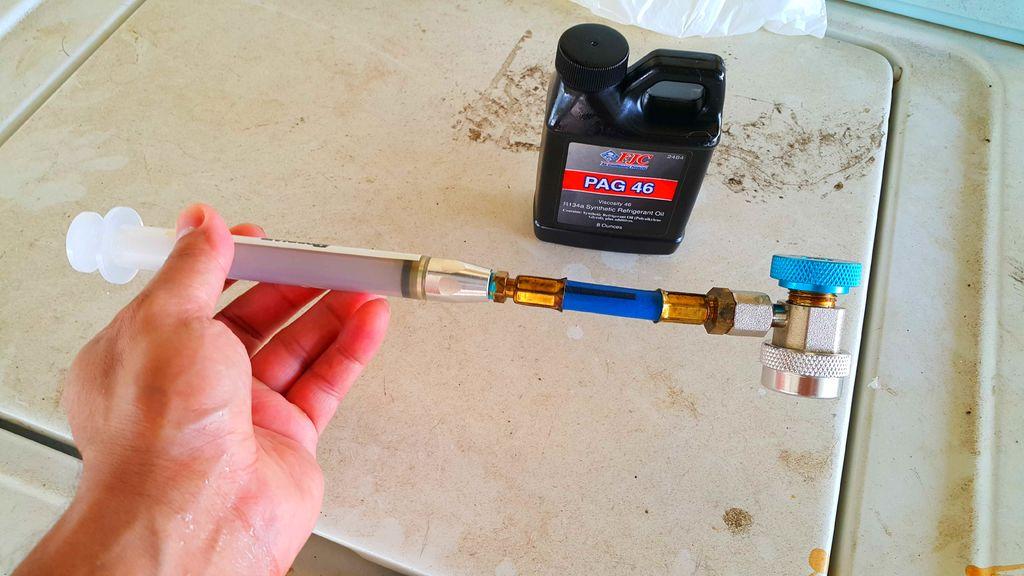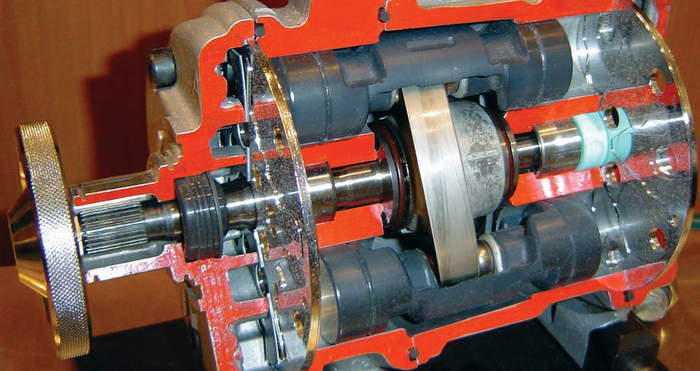To remove PAG oil from an AC system, start by evacuating the refrigerant and then flush the system thoroughly. Ensure all residual oil is purged to prevent contamination or system imbalances.
Removing PAG (Polyalkylene Glycol) oil from an automotive AC system is crucial for maintaining optimal performance. Mechanics and technicians often need to do this when repairing or retrofitting air conditioning units.
Specifically, during component replacement, an AC system may require a complete oil flush to ensure that any contamination or excess oil does not compromise new parts.
It’s a critical step in AC maintenance that ensures that the system operates effectively and avoids potential damage caused by oil or refrigerant mixture imbalances. This task requires precision and understanding of the vehicle’s AC system, as well as compliance with environmental regulations regarding the safe handling of refrigerants.
Properly equipping yourself with the knowledge and tools for this task safeguards both the AC system’s integrity and the environment.

Credit: carfromjapan.com
Introduction To Ac System And Pag Oil
Your vehicle’s air conditioning (AC) system keeps you cool on hot days. It uses a special type of oil. This oil is called PAG oil. PAG stands for polyalkylene glycol. It helps to lubricate the AC compressor. It is important for the system to work right.
The Role Of Pag Oil In Ac Systems
PAG oil has a big job in the AC system. It makes sure the compressor runs smoothly. It also keeps it from wearing out. This oil helps to take heat away from the compressor. Without it, the AC system can’t work well.
Reasons For Removing Pag Oil From The Ac System
Sometimes, you need to take the PAG oil out of the AC system. There might be too much oil, or it might get dirty. Leaks can also mix water with the oil. That’s not good. It can make the AC system not cool well. So, it’s important to remove old or bad PAG oil.
Understanding Pag Oil Contamination
PAG (Polyalkylene Glycol) oil plays a vital role in your AC system. It lubricates the compressor, the heart of your AC. But when contaminants mix with PAG oil, they can cause trouble. Understanding these contaminants is key. It helps you keep your AC system running smoothly. Let’s dive in and learn more about common contaminants and their effects.
Common Contaminants In Pag Oil And Their Effects
Contaminants in PAG oil can come from many sources. Some are easy to spot. Others, not so much! Below is a list of culprits that could spoil the oil:
- Moisture: Water in the system mixes with PAG oil, causing corrosion.
- Debris: Particles from wear and tear in the AC system block the flow.
- Chemicals: Harmful substances may break down the oil’s structure.
- Air: Excess air in the system dilutes the oil’s efficiency.
Each contaminant affects your AC in its own way. For instance, moisture leads to rust inside the system. Debris can cause clogs. This results in poor cooling or even damage.
How Contamination Affects The Performance Of The Ac System
Contamination changes the way your AC works. Here’s what could happen:
- Reduced Cooling: Dirty PAG oil can’t lubricate well. Your AC might not cool as it should.
- Noise: Contaminants cause friction. Your AC might get noisy.
- Wear: Dirty oil means more wear and tear. Parts of your AC could wear out faster.
- System Failure: Too much contamination can lead to a breakdown.
Keep your system clean to avoid these issues. A clean AC system means a happy and cool environment. Stay chill!
Preparation For Pag Oil Removal
Preparation for PAG Oil Removal: Before diving into the process of removing PAG (Polyalkylene Glycol) oil from an AC system, it’s essential to gather the right tools and understand safety protocols. This way, the removal is smooth and free of any potential hazards. Here is the groundwork to set you up for success.
Tools And Materials Required For The Process
Gather these tools and materials:
- Refrigerant recovery machine – to safely remove refrigerant.
- AC flush kit – for cleaning the system.
- Nitrile gloves – to protect your hands.
- Safety glasses – to guard your eyes.
- Waste container – to collect old PAG oil.
- Replacement PAG oil – for refilling.
- Clean rags – for wiping spills.
Safety Precautions And Preparatory Measures
Take these safety steps:
- Wear gloves and glasses before starting.
- Ensure good ventilation in the work area.
- Disconnect the battery to avoid electrical issues.
- Recover refrigerant with the recovery machine.
Follow these tips for a safe and effective PAG oil removal. Remember, safety first.
The Pag Oil Removal Process
Maintaining a clean AC system is essential for performance and longevity. One crucial maintenance task is the removal of PAG (Polyalkylene Glycol) oil from your air conditioning (AC) system. Over time, PAG oil can accumulate moisture and debris, leading to inefficiency or damage. Let’s explore the process to remove PAG oil effectively.
Step-by-step Guide To Draining Pag Oil
To start the drainage, gather the necessary equipment. Make sure the AC system is off. Follow this simple guide:
- Identify and access the compressor.
- Detach the compressor from the AC system.
- Drain the oil by inverting the compressor.
- Measure the amount of oil to replace later.
- Inspect the drained oil for contaminants.
Flushing The System To Remove Residual Oil
After draining, some oil may remain. Flushing is the next key step.
- Connect a flushing agent to the AC system.
- Circulate the flush to clean internal components.
- Allow the flush to dry completely.
- Reinstall the compressor with new PAG oil.
- Recharge the AC system with refrigerant.
A thorough flush ensures all residual oil is removed, preventing any possible mix and contamination with the new oil added later.
Cleaning And Replacement Considerations
Maintaining your AC system requires careful attention to all components. Cleaning the system and adding fresh PAG oil ensures optimal performance. Before you begin, understanding the specific needs related to part replacement and cleaning procedures is crucial. Let’s delve into the critical steps to ensure your AC system runs smoothly with new PAG oil.
Assessing The Need For Part Replacement During Pag Oil Removal
A key initial step involves evaluating components. Look for wear or damage. Correct assessment prevents future issues and ensures system integrity. Follow these tips:
- Check compressor function and signs of contamination.
- Inspect hoses and connections for leaks or cracks.
- Use specialized tools to test system pressure.
Replace defective parts prior to adding new oil. Keep track of any parts that need replacement.
Cleaning And Preparing The Ac System For New Oil
After assessing and replacing any necessary parts, thorough cleaning precedes the oil addition. Eliminate old PAG oil and contaminants to ensure efficiency. Here’s how:
- Drain the system completely.
- Use an approved AC flush to clean internal parts.
- Ensure all moisture is removed—utilize a vacuum pump.
Insert new filters and dryers after cleaning. They play a vital role in trapping debris and moisture. With a clean system, you’re now ready to introduce new PAG oil, which will help your AC system operate at its best.
Recharging The Ac System
Recharging the AC system requires precision and care. It’s essential to remove old PAG oil and replenish it to keep your AC running smoothly. Follow the right steps for a cool, comfortable drive.
Selecting The Right Pag Oil For Your System
Choosing the correct PAG oil ensures your AC system operates at peak efficiency. Check your vehicle’s manual or consult a professional for the specific type needed. Here are key points to remember:
- Check the vehicle’s specs – The manual lists the right oil.
- Consult with professionals – Mechanics offer expert advice.
- Match the oil with the compressor – Not all oils suit every model.
Proper Techniques For Recharging Pag Oil
Correctly recharging your system ensures longevity and performance. Follow these straightforward steps:
- Drain old oil – Remove old oil from the compressor.
- Measure the amount – Use the correct quantity of PAG oil.
- Inject the oil – Use a syringe or a special tool for oil insertion.
- Seal the system – Ensure no leaks are present after recharging.
- Test the system – Run the AC to check for optimal performance.
Always wear safety gear and work in a well-ventilated area. Avoid overfilling, as it can damage the compressor. A successful recharge offers cooler air and better AC efficiency.
Troubleshooting And Tips
Troubleshooting and Tips are crucial after removing PAG oil from an AC system. Correct methods solve common issues and prevent future problems. This guide tackles practical solutions and maintenance practices for a clean, efficient AC system.
Dealing With Common Issues After Pag Oil Removal
Properly handling setbacks is important in the aftermath of PAG oil extraction. Here are common concerns and how to fix them:
- Air and Moisture in the System: Use a vacuum pump to eliminate any air or moisture that might have entered during the oil removal process.
- Residual Oil: Flush the system with an AC flush solvent to remove any lingering oil.
- Clutch and Compressor Failure: Inspect components for damage and replace them if needed to ensure system integrity.
Maintenance Tips To Prevent Future Contamination
Maintaining a clean AC system extends its life and performance. Follow these tips:
| Action | Benefit |
|---|---|
| Regular System Evaluations | Identify potential issues early |
| Use Quality Replacement Parts | Reduce the risk of contaminants |
| Install New Filters | Prevent debris from entering the system |
Always seek professional advice for complex systems and adopt a routine check-up for optimal functionality.

Credit: www.underhoodservice.com
Frequently Asked Questions Of How To Remove Pag Oil From Ac System?
Does Evacuating Ac System Remove Oil?
Evacuating an AC system does remove some oil, but not all. It’s crucial to replenish oil to maintain proper lubrication after evacuation.
How Do You Remove Oil From Ac?
To remove oil from an AC system, first discharge the refrigerant, then dismantle components with oil. Next, drain and flush them using approved AC system cleaner; replace the filter drier. Reassemble, vacuum, and recharge the system following manufacturer’s specifications. Always consult a professional if uncertain.
How Do You Separate Refrigerant From Oil?
Separate refrigerant from oil using a refrigerant recovery machine with an oil separator. Follow manufacturer instructions for safe and effective separation. Regularly maintain equipment to ensure efficient operation and purity of recovered refrigerant.
How Do You Drain Oil From An Ac Compressor?
To drain oil from an AC compressor, start by gathering the necessary tools and safely disconnecting the compressor from the power source. Attach a refrigerant recovery machine to reclaim any refrigerant. Once recovered, remove the compressor drain plug or the compressor itself to drain the oil into a container.
Conclusion
Removing PAG oil from your AC system doesn’t have to be daunting. By following the steps outlined, you can ensure a clean and efficient system. Remember, regular maintenance is key to longevity and performance. Trust in your newfound knowledge, grab your tools, and get started—your refreshed air conditioner awaits!
How to Remove Pag Oil from Ac System?
How to Replace Ac Compressor Without Vacuum?
How Much Does It Cost to Replace an Ac Compressor in a Car?
When to Replace Ac Compressor in a Car?
How Long Does It Take a Mechanic to Replace an Ac Compressor in a Car?
How to Remove Air from Ac System Without Vacuum Pump?
Can I Just Replace the Ac Compressor in My Car?





